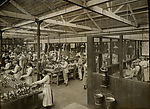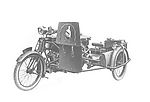 Advertisement in the Dudley Herald, 1st June 1918
Advertisement in the Dudley Herald, 1st June 1918 Sunbeam Ambulance 1917
Sunbeam Ambulance 1917 HM Hobson Ltd, 'Accuracy' Works, Wolverhampton, 1914-1918
HM Hobson Ltd, 'Accuracy' Works, Wolverhampton, 1914-1918 Machine Gun Carrier, Clyno Engineering Co. 1919
Machine Gun Carrier, Clyno Engineering Co. 1919 Machine Gun Corps, 1919
Machine Gun Corps, 1919

Within weeks, the First World War settled into trench-bound attrition, which was swallowing vast numbers of men and resources. It was clear that society would have to change in order to meet the needs of war. The key to this change was the mobilization of women. Women’s working roles expanded as women replaced men and made inroads into occupations traditionally dominated by men. In addition, women who would never have dreamt of going outside the home to work, had both the wish to “do their bit” and the opportunity to do so.
Female employment in the Black Country during the war was probably not the extraordinary experience it was for women in other parts of the country: industries such as engineering, metalworking, chemical and vehicle manufacture already had a significant number of women workers. Similarly, dealing with the competing demands of employment and the conventional roles of housewife and mother was nothing new to Black Country women.
Changes in the workplace were not immediate. Initial attempts to increase and diversify female employment were slow and disorganised, and the Government showed little interest in the matter. One of the first effects of war on working women was to increase the number of unemployed. In the months of September and October 1914, when only a relatively small percentage of men were registered at the exchanges, the number of women standing idle was three times as great. A decline in foreign orders and a "tightening of the belt" at home led to 190,000 unemployed women, mostly in the textile and luxury trades. Encouraged by leading suffragettes, who had set aside their campaign for the vote at the outbreak of war, some women were driven to protest against such inaction. But as the fighting continued women began to take up new roles. Reactions differed; some were enthusiastic, others extremely hostile. Even in wartime, sexism proved a difficult barrier to break through.
During these early months attempts were made to improve the situation for women. Queen Mary established her Needlework Guild. This volunteer group collected, repaired and made garments for those in need. There were protests from the Workers’ National Committee and the Women’s Trade Union League that the activities of well meaning amateurs were threatening the position of unemployed women in the garment trade. The Guild turned its attention instead to making only those items, that would provide additional comforts for serving soldiers and sailors, for the sick and wounded, and their families, and for those unemployed because of the war.
In addition, the Guild received, sorted, packed and distributed gifts from all over Great Britain and from allied and neutral countries. Amongst the gifts received were beautiful, old embroidered towels from Russian peasants, and native work from Zulu chiefs. In ten months over a million articles were collected by the Guild at Friary Court, St James’ Palace. Friary Court was a great clearing-house, but there were branches all over the country, also collecting and distributing goods locally.
As valuable as such voluntary work was, it did not meet the needs of women who needed paid employment. Queen Mary’s Work for Women Fund was created with the objective of providing employment for as many as possible of the women thrown out of work by the war. Mary Macarthur accepted Queen Mary’s request to serve as Honorary Secretary to aid Lady Margaret Crewe, Chairman of the Fund. A string of workshops were opened, providing approximately 9,000 jobs for previously unemployed women. In the ninth month of working the Fund’s Collecting Committee had raised £154,596.
Women employed in the workshops were paid 3d (1p) an hour, with a maximum of 10s (50p) a week for a forty-hour week. Many also benefited from the training schemes developed through the Fund. Women were paid the same amount to attend courses that they would have received in the workshops, and could claim additional travelling expenses.
Australia made the Queen an offer for her Fund. Those accepting the offer had to give an undertaking to go into domestic service for one year. 550 girls went out to Australia. The Fund paid the £1 passage and gave each girl £1 pocket money on arrival. In addition each girl received a trunk containing four sets of underclothing, two print dresses, two overalls, four aprons, a coat and skirt, an afternoon dress, a shirt blouse, an "Ulster", which was type of loose overcoat, three pairs of stockings, six handkerchiefs, a pair of boots, a pair of shoes, one rough towel, two face towels, a brush and comb and a toothbrush. As the demands of Government contracts grew, the need for the workshops diminished, and they began to close, although the training schemes continued for some time.
In May 1915, news that troops were short of high explosives shocked the country. Partly as a result of this scandal a new Government was formed. One of its first actions was to set up a Ministry of Munitions. Headed by David Lloyd George, it quickly brought most munitions production under state control. With the need to increase production, the employment of women was now positively encouraged.
Prior to the war, approximately 200,000 women worked in what became the munitions industry. By the end of the war the number had increased to 900,000. The work was well paid, but extremely hazardous. Factory explosions, sometimes causing fatalities, were common, and workers’ hands and faces turned yellow through handling TNT. Known as “Canaries”, munitions girls became familiar sights in many towns. Over 400 women died from overexposure to TNT during World War One.
In the following year, compulsory male conscription was introduced, making the female workforce even more important. Restrictions that had denied access to particular trades were swept aside, albeit temporarily. With the fittest men in action abroad, women did work of which they were previously believed to be incapable. They came from all classes and went into many different industries. In certain areas the effect was striking. In the field of public transport, the number of female employees increased ten-fold. Administrative, commercial and educational sectors also saw big rises in female labour. They worked in sawmills, drove lorries, bottled beer and manufactured furniture. They worked in foundries, cement factories, jute and wool mills, tanneries and car factories. They were riveters in shipbuilding yards and could be found in quarrying, surface mining and brick-making. They worked on the railways, in power stations, gas works and on sewage farms. They were park attendants and chimney sweeps. Only underground mining, work on the docks and steel and iron smelting were still all-male preserves.
Elsewhere women donned police uniforms and joined special units of the armed forces. Early in 1917, women were invited by the War Office to join the armies overseas, replacing, as far as possible, the men in civilian occupations at the bases. The Women’s Army Auxiliary Corps (WAACs) was established in July 1917. The Admiralty and Royal Air Force followed the example, and established the Women’s Royal Navy Service (Wrens) in November 1917, and later the Women’s Royal Air Force (WRAFs).
Other women joined the Land Army, a remarkable movement set up to ensure the maintenance of a home-grown food supply. It tested the patriotism of its members. They were amongst the worst paid, endured the roughest conditions, suffered much loneliness on isolated farms, and were least under the control of the authorities. They were not received with any enthusiasm to begin with, but by 1918 there were 300,000 women working on the land.
One of the great feats of the war was the mobilization of the nursing services. Within ten days of the outbreak of war, twenty-three Territorial General Hospitals in different parts of the country and 3,000 Territorial nurses, were ready to receive wounded. Others were sent to work, and sometimes die, behind the front lines in France.
It was a long war, but most women had always accepted the temporary nature of their new work. In many instances, contracts of employment had been based on collective agreements between trade unions and employers, which decreed that women would only be employed, for the duration of the war. Returning soldiers expected them to stand aside and let men resume their old positions. By summer 1920, over 60 per cent of all the women who entered employment during the war had left it again. As unemployment continued to soar, married women found themselves further discriminated against as a marriage ban was introduced in a number of occupations.
Despite some backward steps, women’s role in the workplace had moved forward. The increase in the number of women trade unionists from only 357,000 in 1914, to over a million by 1918, represented an increase of 160 per cent, and forced unions to deal with issues surrounding women’s employment. Women’s position in society had also changed. The constraints of Edwardian life had loosened, certain prejudices had been overcome and new opportunities had opened up. The collapse of traditional women’s employment was hastened, particularly domestic service. In February 1918, the Representation of the People Act gave votes to 6 million women, who owned property and were over the age of 30. Some historians suggest that this was in acknowledgement of the vital contribution made by women to the war effort.
Rollover the captions in the box to see the available images in thumbnail format, click the caption to see the full-size image
| Reference: | 752 |
| Keywords: | |
| Archive Ref: | |
| Updated: | Wed 23 Apr 2008 - 1 |
| Interpretation written by | Barbara Harris |
| Author's organisation | |
| Organisation's website |